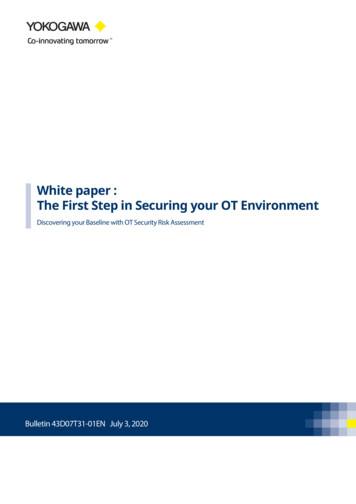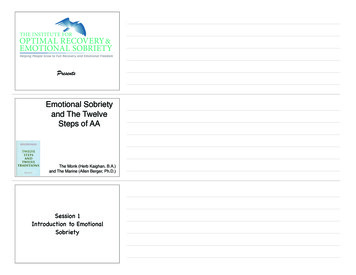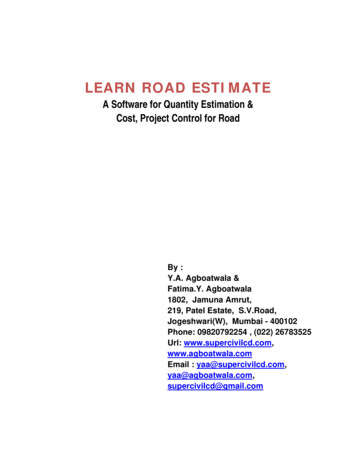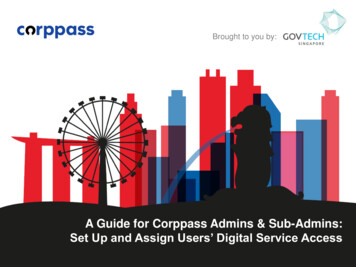
Transcription
White paper :The First Step in Securing your OT EnvironmentDiscovering your Baseline with OT Security Risk AssessmentBulletin 43D07T31-01EN July 3, 2020
Whitepaper: The First Step in Securing your OT Environment – Discovering your Baseline with OT Security Risk AssessmentContents1.Executive Overview . 32.The Current State of OT Security . 43.Why OT Security is Harder than Ever . 74.Taking a Risk-based Approach to OT Security . 95.Starting Point to Obtaining the Baseline: Technical Security Risk Assessment . 126.Business Benefits and Case Studies . 177.Conclusion . 192
Whitepaper: The First Step in Securing your OT Environment – Discovering your Baseline with OT Security Risk Assessment1. Executive OverviewEnterprises today rely on high levels of automation and Information Technology (IT) to meet theglobal demand for supplies in a modern competitive world. Managing Operational Technology (OT)security is one of the leading business challenges to achieving reliability and availability, ensuringhealth and safety, and meeting regulatory compliance. Furthermore, triggered by the outbreak ofCOVID-19, executives are actively looking into reconsidering and improving business operations.From the business continuity perspective, cyber security management plays a vital role.Organizations face the following issues in managing OT security: Difficulty in assessing risk due to low visibility of OT assets Mitigating risk and prioritizing investment Keeping up with industry standards and incorporating safety systems in the scope Managing security risk throughout the entire plant lifecycle with limited OT expertiseThis whitepaper describes how companies and organizations can address the above challenges bytaking the risk-based approach to cybersecurity management. Readers will learn: Why the risk-based approach is essential for effective security risk management How technical security risks assessments determine the security baseline How the outcomes of the assessments will lead to efficient investment and risk management3
Whitepaper: The First Step in Securing your OT Environment – Discovering your Baseline with OT Security Risk Assessment2. The Current State of OT SecurityIn a modern competitive world, the efficiency of industrial systems needs to be optimized andincreased to meet the global demand for supplies. As a result, this leads to systems becoming morecomplex with an increased reliance on high levels of automation and IT. Although using IT hasprincipally benefitted the industry, it also brought new challenges to OT security.Digital transformation accelerating IT/OT convergence and cyber threatMany of the industrial plants that were once completely isolated are now connected with the outerworld. Companies are striving to transform their operations and businesses digitally forcompetitiveness, by connecting not only vertically within their plant, but also horizontally withinsites, companies, and across the supply chain. The vast connection creates not only businessopportunities but also challenges in securing the network and data.With more components and functions required to optimize the operation, industrial plants arebecoming increasingly complex and automated, and the use of IT in industrial environments is nowessential. However, these commercial off-the-shelf technologies like Windows, Ethernet, andTCP/IP have typically been developed for environments with less stringent requirements. Thisresults in industrial plants having larger attack surfaces, which lead to considerably larger exposureand increased probability of facing cybersecurity issues.Research shows that the top three cyber threats are devices and "things" added to the network,internal threats (accident), and external threats (supply chain or partnerships), which are allaccelerated from IT/OT convergence (Figure 1) [*1].4
Whitepaper: The First Step in Securing your OT Environment – Discovering your Baseline with OT Security Risk AssessmentFigure 1: Leading Cyber Threats as per SANS 2019 State of OT/ICS Cybersecurity SurveyHigh reliability and availability requirements leading to difficulty in securitymanagementResponsible for the critical infrastructure supporting our everyday life and business operation;reliability and availability requirements for industrial control systems are naturally very high. Forasset owners, the high reliability and availability requirements make effective securitymanagement very difficult, as they wish to refrain from making unnecessary updates if the systemis running without any current problems.Industrial systems arising as potential targetsCriminals and state actors have become aware of the potential target of industrial systems.Targeting critical infrastructure has a significant impact on society, while the cyber security ofindustrial systems is generally less mature than those of other IT sectors.The increasing number, variety and impact of cyber threats in the OT domain can no longer beignored. Threats vary from unintentional infection through USB devices, to disgruntled employeestrying to cause harm or blackmail, up to nation-state attacks with the intent to cause death anddestruction. The last example refers to the Triton attack in 2017, where a nation-state actor wassuspected of having modified the safety system of a plant to cause severe damage. The attackfailed, however, due to an error made by the attackers that exposed their effort.5
Whitepaper: The First Step in Securing your OT Environment – Discovering your Baseline with OT Security Risk AssessmentNot only can these security breaches have serious operational and safety consequences, but it canalso affect your business in different ways. Think of economic damage or reputational damage,when a part of the plant becomes locked down due to malware. Most companies, including boardsand executive leaders, now recognize cyber risk as one of their top business risks (Figure 2) [*1].Figure 2 – OT/ICS cybersecurity risks as significant contributors to company risk profile as perSANS 2019 State of OT/ICS Cybersecurity Survey6
Whitepaper: The First Step in Securing your OT Environment – Discovering your Baseline with OT Security Risk Assessment3. Why OT Security is Harder than EverIndustrial control systems serve as the brain of the plant. Its availability, resilience, andsustainability will significantly impact the availability of the entire plant, as well as safety,operational cost, and business performance. As seen in recent plant shutdowns triggered byransomware attacks, security incidents can bring negative impact to top management andstakeholders.Furthermore, as the entire world faced an extremely challenging economic and business situationin 2020 due to the outbreak of COVID-19, executives are looking into reconsidering and improvingbusiness operations from the business continuity perspective, preparing for operation under astate of emergency. Security risk management, which is creating a sustainable system to manageand mitigate security risk, is a top priority for organizations and responsible teams; however, it isharder than ever due to the following challenges:Difficulty in assessing risk due to low visibility of OT assetsSince industrial plants expand and evolve during their long lifecycle, it is challenging to gain visibilityof OT assets. The SANS 2019 State of OT/ICS Cybersecurity Survey shows that less than 36% ofrespondents claim to have a comprehensive overview of all the elements of control systemssecurity for their enterprise or plant. As top 2019 initiatives for increasing OT/control system andnetwork security, 45.5% of respondents raised "Increasing visibility into control system cyberassets and configurations," whilst 37.3% stated, "Perform security assessment or audit of controlsystems and control system networks."[*1].Organizations are not reaching down into the ICSinfrastructure to monitor those assets considered to have the highest impact if exploited.Mitigating risk and prioritizing investmentTeams responsible for OT security need to justify investment decisions and explain to the boardmembers on the current risk they are facing, where to spend the initial investment, and the entireinvestment plan to mitigate security risk for their enterprise. Yet many companies lack visibility intheir OT assets, therefore making it impossible to explain clearly how much they need to investand where to start. If companies implement security measures on an ad hoc basis, this will lead toinefficient spending of budget and resources, with no one knowing whether the security risk wasreduced.7
Whitepaper: The First Step in Securing your OT Environment – Discovering your Baseline with OT Security Risk AssessmentKeeping up with industry standards and incorporating safety systems in thescopeImplementing countermeasures and continuing to be compliant with emerging standards alone ischallenging. Research suggests NIST CSF (Cyber Security Frameworks), ISO 27000 series, NIST 80053, NIST 800-82, ISA/IEC62443, and CIS Critical Security Controls are being referred to by manycompanies. There is no single regulation, standard, or best practice that cover all aspects andregions.[1] In the case of Europe, the European NIS (Network and Information Systems) directivehas been rolled out and will result in laws per country. The GDPR compliance is another exampleshowing that regulations must to be followed in a security program.Additionally, from the risk management perspective, it is highly recommended to comply with thetwo standards, IEC62443 and IEC61511, which are currently separately defined. In the recentlypublished edition of IEC61511, a technical standard-setting practice in the engineering of SafetyInstrumented Systems, it is explicitly stated that conducting security risk assessments have nowbecome a mandatory requirement.Managing security risk throughout the entire plant lifecycle with limited OTsecurity expertiseWhile the implementation and management of the security measures must be continuedthroughout the plant lifecycle, which lasts for more than 20 years, security teams face the lack ofsecurity personnel and expertise when it comes to security. According to research regardingsecurity skill gaps, more than 85% of respondents claim that their security teams are understaffedand feel overworked compared to the previous year. Also, 94% responded that the skills requiredto be an excellent security professional have changed in the past few years, which shows thatsecurity experts face difficulty in keeping up with the latest technology trends and security threats[2].8
Whitepaper: The First Step in Securing your OT Environment – Discovering your Baseline with OT Security Risk Assessment4. Taking a Risk-based Approach to OT SecurityWhy take the risk-based approach?Taking the risk-based approach will effectively reduce risk at significantly less cost. According to acase study from McKinsey & Company, the maturity-based approach, which is building the highestlevel of defense around everything, costs a total of 14 million Euros. However, the risk-basedapproach, which optimizes defensive layers for risk-reduction and cost, costs a total of 5 millionEuros, which is almost one-third of the traditional method [3].Key requirements for taking a risk-based approachThe following are the four key requirements in taking a risk-based approach to OT security.Determine the security baselineBefore risks can be managed, they first must be identified and assessed by a risk assessment. A riskassessment enables OT security stakeholders to understand the baseline. Acknowledging thecurrent status of the plant is fundamental and is the starting point of the security journey.Define risk from a holistic viewRisks come from many different directions and categories. For example, a risk assessment that onlyfocuses on high-level business processes might fail to identify risks due to flaws in technicalimplementations. Insufficiently defined leadership regarding security at the boardroom level is arisk, but a poorly configured firewall is also a security risk.Therefore, it is essential to have a scope that is sufficiently broad and incorporates different partsof the organization. Furthermore, a combination of a paper review with an onsite, technicalassessment is vital for a comprehensive risk assessment.9
Whitepaper: The First Step in Securing your OT Environment – Discovering your Baseline with OT Security Risk AssessmentComply with security standards for guidanceCompliance with a security standard is beneficial since it makes the implementation of a securityprogram more effective and straight forward compared to the alternative of reinventing the wheelon your own.In the OT security domain, there are many emerging security standards, like there are manystandards for the IT domain. Currently, many OT security stakeholders follow the guidelines of theIEC 62443, which is becoming the key standard in the industry. IEC62443 is designed for industrialsystems and is, therefore, more suited for the purpose than other security standards that are notexplicitly focused on industrial systems. As an entire series of standards, IEC62443 covers everyaspect of a security program, ranging from risk assessments to technical design specifications.The IEC 62443 level approach is to define a target security level for your plant or zones of yourplant (Table 1). Companies are required to establish the correct target security level upon assessingtheir plant.Table 1 - Security Level based on the description in IEC62443-3-3Establish a systematic processOrganizations must follow a systematic process to establish a persistent operational riskmanagement process for OT security. This risk management process is a strategic activity thatinvolves short- and long-term considerations. Thus, planning for strategic risk management isnecessary to ensure continuous risk assurance.10
Whitepaper: The First Step in Securing your OT Environment – Discovering your Baseline with OT Security Risk AssessmentAdopting a risk-based approach will guide organizations to make complex decisions, on whichaction to take, and where to invest. Effective risk management starts with knowing and thoroughlyunderstanding your risks. However, the complex operational environment, evolving cyber threats,and continuously updated laws and policies make this responsibility extremely challenging fororganizations to handle on their own. Therefore, many companies are seeking for support fromsecurity partners when it comes to security assessments. According to a recent survey, 64% of thecorporate security experts mentioned that their company would benefit from outside help [2].11
Whitepaper: The First Step in Securing your OT Environment – Discovering your Baseline with OT Security Risk Assessment5. Starting Point to Obtaining the Baseline: TechnicalSecurity Risk AssessmentTo take a risk-based approach to cyber security management, Yokogawa recommends theTechnical Security Risk Assessment as the starting point to obtaining the OT security baseline. Byassessing the impact and likelihood associated with threats facing the OT environment, theTechnical Security Risk Assessment determines the security risk to the organization.Overview of the Technical Security Risk AssessmentYokogawa's Technical Security Risk Assessment starts with a vulnerability assessment that aims toidentify which vulnerabilities are present in the OT environment. When the vulnerabilities areidentified, a scenario-based risk assessment is conducted to define the highest risks facing the OTenvironment, and which problems need to be solved most urgently. Vulnerabilities and risks arenot the same, a vulnerability is a flaw or weakness while a risk is the probability of something badto happen.In the technical vulnerability assessment phase, multiple methods are used to gathervulnerabilities, verify and check findings, and create a complete and reliable picture of thevulnerabilities that exist in the environment.12
Whitepaper: The First Step in Securing your OT Environment – Discovering your Baseline with OT Security Risk AssessmentThis database of vulnerabilities will be the input of the risk assessment phase and will be conductedby the same team that was involved in the vulnerability assessment phase. This means that a largeamount of knowledge and insight regarding the vulnerabilities facing the OT environment will bepresent at the start of the risk assessment.A report will conclude the technical risk assessment. This report includes findings on any high-levelrisk and the immediate actions required, a list of risks and vulnerabilities, a gap analysis betweenthe existing state of the plant and security requirements, and a roadmap on how to develop orimprove the security program; this includes the planning of countermeasures and other concreterecommendations.Vulnerability assessment phaseIEC62443 defines vulnerability as a "flaw or weakness in a system's design, implementation, oroperation and management that could be exploited to violate the system's integrity or securitypolicy."A consultant and an engineer will perform the vulnerability assessment. During the assessment,several methods are used to collect a database of vulnerabilities. Typical methods includeconducting interviews and technical inspections.The Yokogawa consultant goes through an extensive questionnaire that contains questions basedon both the IEC62443 and Yokogawa extensive security experience. The questions vary fromdetailed technical implementation to how security is managed by the local organization.Upon cooperation with the customer's local OT security organization, the Yokogawa engineerinvestigates the state of security through hands-on technical inspections. Networks andcomponents such as User and PC Management, Network Devices, Patch, and AntivirusManagement Servers are accessed and manually investigated.Risk assessment phaseOnce the assessment reveals the vulnerabilities of the system, the next step is to define the risk tothe system. The risk will be determined by assessing the impact and the likelihood of each scenario.IEC62443 defines risk in the following formula.13
Whitepaper: The First Step in Securing your OT Environment – Discovering your Baseline with OT Security Risk AssessmentThe Yokogawa Security Consultant leads the risk assessment workshop. A multidisciplinary teamof experts and stakeholders from the customer must be present to support the accuratequantification of risks. During this workshop, the findings of the assessment are presented, and therisk is calculated with input from customer specialists with a technical, safety, financial, andenvironmental background.Based on industry experience and vulnerabilities identified in the previous phase, the consultantpresents threats and determines the likelihood of a scenario being exploited (Table 2).Table 2 – Likelihood level definitionThe consultant also explains the consequence of the system when this scenario is exploited.An example threat scenario could be a disgruntled employee installing ransomware, which willhold the system hostage via an infected USB stick.The consultant will evaluate the vulnerabilities in physical protection and finds that it is easy toinsert a USB stick. Another vulnerability is that the software is only updated every three months,which makes it possible for known malware to spread over the network. The backups are notstored offline but on the backup server, which will be infected as well.In the above example, the likelihood is: LikelyThe impact of the threat scenario is determined by the customer, who is best in assessing theimpact on the operational process. Based on the explanation, it is clear for the customer that alloperator stations are lost in this scenario, including the backups, which means the plant will bedown for a long time.The impact is split into four subjects: safety, environment, financial, and reputation impact. For alltopics, the 'likely' impact is determined, and the highest impact score is used for the risk calculation(Table 3).14
Whitepaper: The First Step in Securing your OT Environment – Discovering your Baseline with OT Security Risk AssessmentTable 3 – Impact Level DefinitionThe combination of the two determines the risk (Table 4).Table 4 – Risk Level DefinitionIn addition, the effectiveness measured in risk reduction of possible countermeasures will beassessed when the unmitigated risk is considered too high.15
Whitepaper: The First Step in Securing your OT Environment – Discovering your Baseline with OT Security Risk AssessmentTechnical Security Risk Assessment ReportThe result of the risk assessment and the vulnerability assessment is documented in the TechnicalSecurity Risk Assessment Report that contains: An executive summary An overview of the used methodology An overview of the risks facing the OT environment An overview of the vulnerabilities that are present in the OT environment A gap analysis between the existing state of the plant and the security requirements A roadmap on how to develop or improve the security programThe outcome of the assessment will support constructive discussion with the management onwhat immediate measures need to be taken to address the high-level risk, and how to plan aneffective security program to implement the countermeasures.Yokogawa has extensive experience in OT security, ranging from developing policies andprocedures for security governance, secure network design and implementation, and providingmanaged services. Yokogawa will help with addressing any of the issues revealed during the riskassessment and support customers in continuing with their security journey.16
Whitepaper: The First Step in Securing your OT Environment – Discovering your Baseline with OT Security Risk Assessment6. Business Benefits and Case StudiesBusiness benefits: Reduce enterprise risk with minimal investmentBased on the outcome of the Technical Security Risk Assessment, companies will be able to identifyrisks and create mitigation plans to address the highest risks and remove critical vulnerabilities.With more insight in risks, assessments help OT security stakeholders better prioritize the actionsto be taken, effectively reducing security risk while optimizing investment.The draft roadmap will support companies to create a mid to long term plan on how to carry onthe security program for their plant and in which manner to implement the countermeasures. Thisroadmap also avoids inefficient investment and unmanageable security controls while complyingwith industry standards.Case StudyThe following case study introduces how Yokogawa addressed the customer's challenges throughthe Technical Security Risk Assessment.Customer ChallengesThe customer has multiple plants at a single location. All the plants are working standalone buthave a local DMZ and a network connection to one central upper zone. The customer suspects thatthe security of their plants is not where it should be, but a clear overview of high priority issues isnot present. Besides some small-scale ad hoc initiatives to improve security pushed by the head ofthe local IT department, not much has happened for the past ten years. During that same period,the OT infrastructure has been steadily growing, and various systems have been interconnected.Concerns about security have occasionally been raised to low-level management, but no decisiveaction was taken because the precise nature of the risks and the cost to mitigate always remainedvague and unclear.From the higher-level management, clear instructions were issued that actions must be taken. Thecustomer started from the IEC62443 standard and has set Security level 2 requirements (SL 2) foreach plant. However, the local organization struggle on how to implement security on delicate OTinfrastructure. While the IT organization is willing to support, they lack knowledge of the OTdomain. The team struggles where to start and how to change the organization.SolutionYokogawa proposed to perform a Technical Security Risk Assessment to map the current securitystatus of the plants. By this assessment, Yokogawa measured the current state of security of theplant to determine which IEC 62443 security requirements are met and which are not. After thismeasurement, Yokogawa created a roadmap for each plant with a plan to add additional securitycountermeasures to reach the required security level.17
Whitepaper: The First Step in Securing your OT Environment – Discovering your Baseline with OT Security Risk AssessmentOutcome and Customer FeedbackBased on the IEC62443 requirements list, the gaps and vulnerabilities were listed. Below is anexample of a single IEC62443 requirement with a recommendation on how to comply based on theassessment.Example of IEC62443 Requirement and Recommendation:SecuritySecurityRequirement LevelTitleSR 1.1.1Unique identification and authentication Not Compliant2CompliancyThe control system shall provide the capability to uniquely identify and authenticate all human users.RecommendationExplanationAvoid shared user accountsAll users should have their unique user account. If multiple individualsuse the same user account or login credentials, it is not possible tocomply with this requirement.Active Directory integration Active Directory allows individuals to use their unique user account toauthenticate on multiple systems. Without Active Directory, it is verycomplicated to comply with this requirement in an environment thatcontains multiple users and computers.The roadmap provided to the customer listed all vulnerabilities that must be addressed to meetthe security goal of the customer. The roadmap started by listing critical vulnerabilities that mustbe resolved immediately. It was followed by recommendations that require relatively little effortand have a significant contribution to reduce security risks, such as implementing a physical keyswitch on the safety controllers; and to increase the patch and antivirus update frequency. Theroadmap ended with the more complex recommendations that will take considerable time andeffort to realize, such as create security policies and procedures, upgrade all legacy systems, andimplement centralized monitoring.The customer was satisfied with the roadmap. It provided a clear overview of the necessary stepsand where to start. After concluding the technical risk assessment, Yokogawa was asked to providea quotation for the implementation.Yokogawa worked with the customer to create a feasible investment plan to meet the customer'sbudget while addressing the highest risk vulnerabilities.18
Whitepaper: The First Step in Securing your OT Environment – Discovering your Baseline with OT Security Risk Assessment7. ConclusionOT security is a high priority at the management level to ensure health and safety and meet themarket demand with maximized plant availability. Executives are also actively looking intoreconsidering and improving business operations, and cyber security management plays a key rolein business continuity.Security risk management is challenging for many organizations due to low visibility in OT assetsleading to difficulty in prioritizing investment for effective risk management. Keeping up with thecontinuously updated industry standards and managing security risk throughout the entire plantlifecycle also makes it difficult for organizations to tackle the challenge by themselves with limitedOT expertise.Adopting a risk-based approach to cybersecurity will guide organizations to make complexdecisions, on which action to take, and where to invest. Before risks can be managed, they firstmust be identified and assessed by a risk assessment. Acknowledging the security baseline of theplant is fundamental and is the starting point of the security journey.Yokogawa's Technical Security Risk Assessment sets the foundation and direction for companies toplan and execute their security risk management program. By using multiple methods to gathervulnerabilities, verify and check findings and create a complete and reliable picture of thevulnerabilities that exist in the environment, Yokogawa assesses the impact and likelihoodassociated with threats facing the OT environment and determines the security risk to theorganization.The outcome of the assessment will support constructive discussion with the management on whatimmediate measures need to be taken to address the high-level risk, and how to plan an effectivesecurity program and implement the required countermeasures. With more insight into risks,assessments help OT security stakeholders to prioritize the actions to be taken, effectively reducingsecurity risk while optimizing investment.Risk management will guide in a complex operational environment with mazes of laws, policies,and directives, along with an evolving threat landscape. Since this can be challenging even for themost experienced professional, many companies are seeking for support from security partnerswhen it comes to security assessments. With in-depth knowledge and vast experience in both plantoperation and OT security, Yokogawa's consultants and engineers will guide you along the securityjourney.For more information, please visit our website ex/oprex-lifecycle/oprex-safety-and-security/19
Whitepaper: The First Step in Securing your OT Environment – Discovering your B
The SANS 2019 State of OT/ICS Cybersecurity urvey shows that less than S of 36% . NIST 80082, ISA/IEC62443- and CIS Critical Security Controls are being referred to by many , companies. There is no single regulation, standard, or best practice that cover all aspects and . which lasts for more than 20 years, security teams face the lack of











